KEKS (Kunst, Erziehung, Kybernetik, Soziologie) / Pädagogische Aktion (PA) (München / Nürnberg), gegründet/ founded 1968
English text see below
1968 verändern Kinder mit Farbe und Materialien aller Art die ehemalige Villa von Heinrich Himmler im Münchner Stadtbezirk Bogenhausen. Die kunstpädagogische Aktion „Projekt Möhlstrasse“ erregt viel Aufsehen. Von Wolfgang Zacharias (1941-2018) und Hans Mayrhofer (geb. 1942) initiiert, wird sie zum Vorbild kommender Aktionen der Gruppe KEKS, die Zacharias 1968 zusammen mit Fridhelm Klein (geb. 1938), Peter Buchholz (geb. 1939), Michael Popp (1942–2017), Mayrhofer, Gerd Grüneisl (geb. 1944) und Haimo Liebich (geb. 1945) gründet.
Die Aktion ist das zentrale Moment ihrer neuen Kunstpädagogik. Die Aktion oder Spielaktion ist für KEKS die Methode, um eine vorgefundene Situation – idealerweise im öffentlichen Raum – im Kollektiv lust- und phantasievoll umzugestalten. In Rahmen der KEKS-Aktionswochen 1969 nehmen Schüler in München, Nürnberg und kleineren Städten Bayerns den öffentlichen Raum in Besitz, deuten Denkmäler um, oder füllen an der Strassenkreuzung Autoabgase in Plastiktüten (Aktion „Saubere Luft“). Zwischenzeitlich schliessen sich bis zu 60 Studenten und Kunsterzieher der Initiative KEKS an, die auch für eine neue Bildungspolitik kämpft. Eine offensive Kommunikation, Flugblätter und die durchgehende Dokumentation der Aktionen sind zugleich politische und kunstpädagogische Strategie.
Die KEKS-Aktionen finden in Nürnberg und München in unterschiedlichen soziopolitischen Kontexten statt: In Nürnberg ist seit 1964 Hermann Glaser Kultur- und Schulreferent und will die kulturellen Institutionen der breiten Bevölkerung, vor allem den Kindern und Jugendlichen, öffnen. Nürnbergs progressive Kulturpolitik erregt dabei landesweites Aufsehen. Im Schulunterricht bringen die KEKS-Leute pionierhaft Film und Fotografie ins Spiel. Besonders Klein experimentiert ausgiebig mit Bild, Ton und Film als kunstpädagogische Verfahren. So baut er 1967 mit Nürnberger Schülern einen „Bild-Klang-Raum“, ein mobiles Gerüst, wo Film- und Bildsequenzen zu Ton und Bewegung umgestaltet werden.
Von Dietrich Mahlow, Gründungsdirektor der Kunsthalle Nürnberg, zur Biennale 1969 Nürnberg eingeladen, richten Klein und Popp einen Aktionsraum für kunstpädagogische Experimente ein. Er ist mit diversem Material und technischen Geräten wie Kameras, Kopiergeräten, Projektoren, etc. ausgestattet. Über Mahlow wird KEKS 1970 zur 35. Biennale Venedig eingeladen. Dort richten sie einen Aktionsraum nach dem Nürnberger Vorbild ein. Dazu kommen performanceartige Aktionen mit Kindern, so der Bau eines freien Übergangs für die Kinder vom angrenzenden Stadtteil Castello in die Biennale.
Während in Nürnberg Kunstpädagogik und Soziokultur im Zentrum stehen, entwickeln sich die KEKS-Aktionen in München in Richtung Spielpädagogik. Es geht um die „Inszenierung des Stadtraumes als Spielplatz“ wie anlässlich der „Spielaktion Johannisplatz“ 1971: Dort hebt auf einem bestehenden Spielplatz ein Bagger ein riesiges Loch aus: Es ist die Aufforderung an die Kinder, sich den Platz anzueignen und mit dem vorhandenen Material neu zu gestalten. Die „Spielaktion Johannisplatz“ steht für den Übergang vom politisch-gesellschaftlichen Aktivismus zur städtisch finanzierten Spielplatzbetreuung. Die „Laborsituation“ von KEKS geht damit dem Ende entgegen und die Spielpädagogen nennen sich in Pädagogische Aktion (PA) um.
Im Auftrag des Stadtjugendamtes München organisiert PA unzählige Spielaktionen. 1972 erhält die PA den Auftrag, das Spielkonzept für die Olympiade in München zu erarbeiten. Neben Spielaktionen und -einrichtungen im Olympiadorf besucht ein Spielbus die städtischen Spielplätze, bringt Recyclingmaterial und neue Spielsituationen in alle Stadtteile.
1990 führen interne Konflikte zur Spaltung von PA; die Nachfolgevereine führen die kulturelle Kinder- und Jugendarbeit bis heute weiter.
© The Playground Project 2018 / Gabriela Burkhalter
KEKS (Art, Education, Kybernetic, Sociology) / Pädagogische Aktion (PA) (München / Nürnberg), founded 1968
In 1968, children use paint and a range of other materials to transform Heinrich Himmler’s Villa in Munich-Bogenhausen. The educational art action ‘Project Möhlstrasse’ attracts a lot of attention. Initiated by Wolfgang Zacharias (1941–2018) and Hans Mayrhofer (b. 1942), it becomes the prototype for future actions from the group KEKS, founded by Zacharias in 1968 together with Fridhelm Klein (b. 1938), Peter Buchholz (b. 1939), Michael Popp (1942–2017), Mayrhofer, Gerd Grüneisl (b. 1944) and Haimo Liebich (b. 1945).
The ‘action’ is the core element of their new style of art pedagogy. For KEKS the ‘action’ or ‘play-action’ is a method for reimagining an existing situation—ideally in the public realm—in a way that is driven by pleasure and imagination and realised collectively. As part of the KEKS Action-weeks in 1969, students in Munich, Nuremberg and smaller Bavarian towns occupy public spaces, reinterpret monuments, or fill plastic bags with exhaust fumes at intersections (Action Clean Air). Meanwhile, students and art educators from KEKS rally for a new policy on education. The aggressive communication strategy, leaflet distribution and the continuous documentation of the actions are simultaneously political and pedagogical strategies.
The KEKS-actions in Munich and Nuremberg take place in differing socio-political contexts: In Nuremberg, Hermann Glaser has been a culture and education commissioner since 1964, and wants to open cultural institutions up to the wider public, in particular to children and young people. Nuremberg’s progressive attitude to cultural policy draws nationwide attention. Members of KEKS pioneer the use of film and photography in the classroom. Klein in particular experiments extensively with images, sound and film as pedagogical strategies. In 1967, with the help of schoolchildren, he builds an ‘image-sound-space’. A mobile set-up, where film and image sequences are transfigured into sound and movement. Dietrich Mahlow, the founding director of the Kunsthalle Nuremberg, invites Klein and Popp to participate in the 1969 Nuremberg Biennale; they set up an Action Room devoted to experiments in art education. It is equipped with an array of materials and technical devices like cameras, copy machines, projectors, etc.
In 1970, through Mahlow, KEKS is invited to the 35th Venice Biennale. There they set up an Action Room based on the Nuremberg model. In addition to this there are performance-based actions with children, such as the construction of a free crossing into the Biennale for the children from the adjacent neighbourhood of Castello. While art-pedagogy and socio-cultural practices are the focus in Nuremberg, in Munich the KEKS actions develop more in the direction of the play-pedagogy. There, it’s about ‘staging urban space as a playground’, as evident on the occasion of the ‘Play-Action at Johannisplatz’ in 1971. There, a digger makes a huge hole in an existing playground: it is then up to the children to design a new playground using the materials available. The ‘Play-Action at Johannisplatz’ represents the transition from social-political activism to a city-funded playground development. The “laboratory phase” of KEKS thus comes to an end and the play-pedagogists instead call themselves Pedagogical Action (PA).
Appointed by the Department for Youth in Munich PA organises countless play-actions. In 1972, the PA are commissioned to work on a play-concept for the Olympic Games in Munich. Alongside play actions and facilities in the Olympic Village, a play-bus visits the municipal playgrounds in the city, bringing recycling materials and new play set-ups to every quarter of the city.
In 1990, internal conflict causes the fracture of PA, the resulting organisations continue to carry out cultural youth work for children and young people until today.
© The Playground Project 2018 / Gabriela Burkhalter
Quelle
Tanja Baar, Die Gruppe KEKS – Aufbrüche der Aktionistischen Kunstpädagogik, kopaed, München 2015
https://www.spielkultur.de/ueber-uns/geschichte/
Heger, Natalie. 2014. Das Olympische Dorf München: Planungsexperiment und Musterstadt der Moderne. Berlin: Reimer.
Gabriela Burkhalter: Manyfold paed-action und architettura d’animazione, in: Aktionsräume. Der Fahrende Raum Flugschrift No2, Florida Magazin No4, München 2017/18
Quelle Bilder: Spiel und Sport in der Stadtlandschaft : Erfahrungen und Beispiele für morgen / hrsg. von Gerda Gollwitzer … [et al.]. – München : Callwey, 1972 ., S. 56-60.
Heger, Natalie, S. 213
angepasst 17.9.2014, updated on January 23, 2019
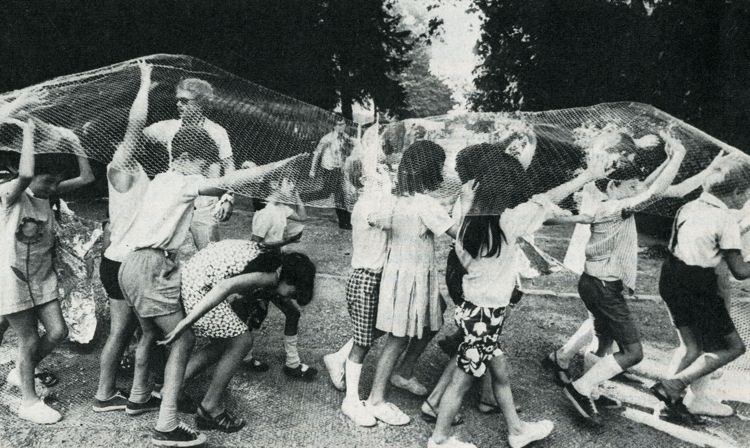
Biennale Venedig 1970: Experimente KEKS, werk 10/70
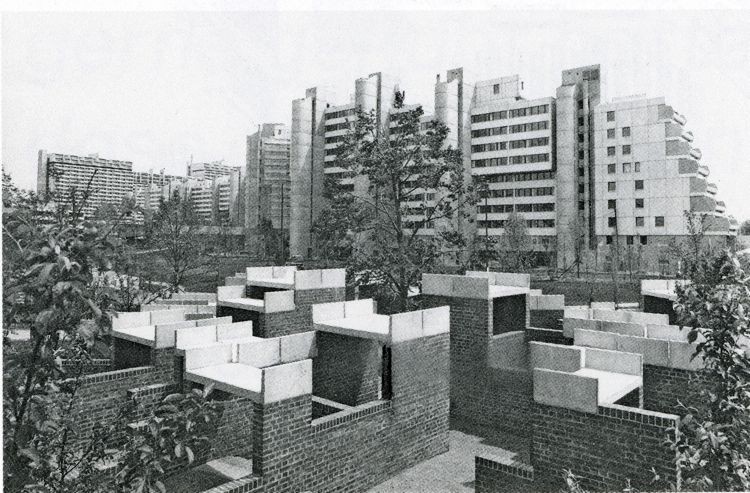
Spielplatz „Rote Stadt“, Olympiadorf München, c. 1972
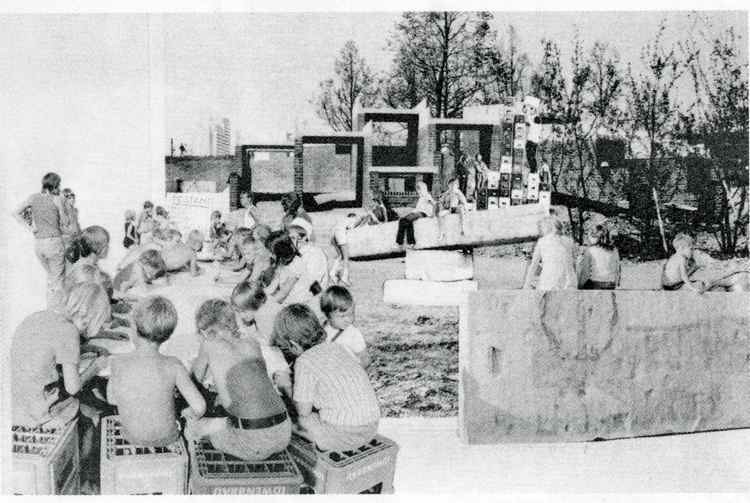
Collage „Rote Stadt“, c. 1972
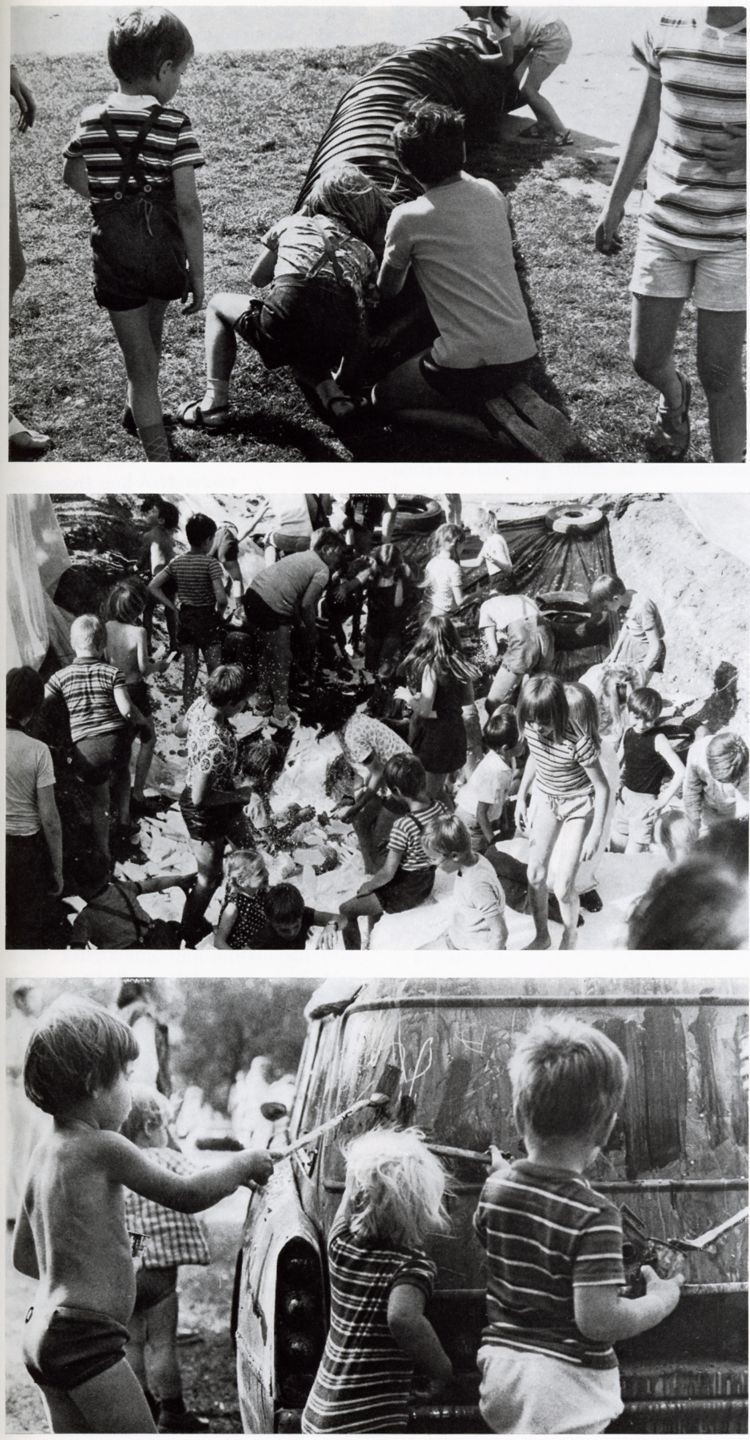
Pädagogische Aktion: Spielaktionen
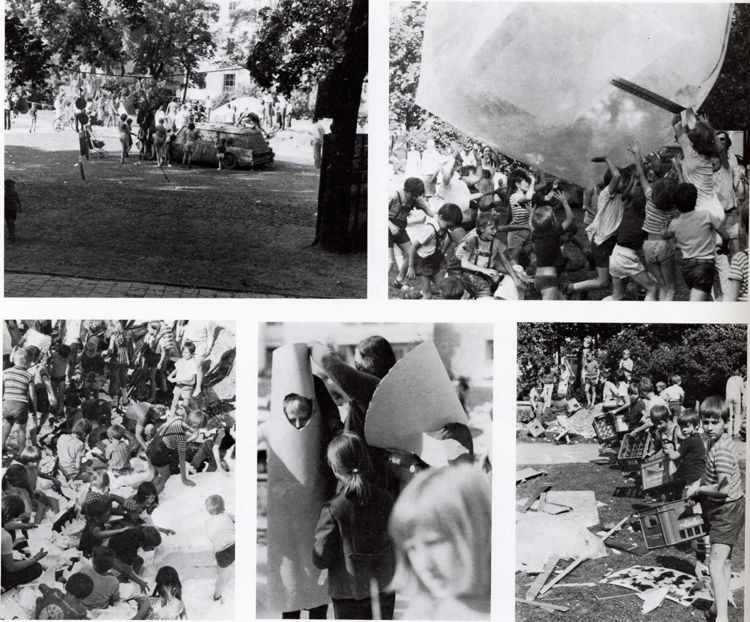
Aktion Johannisplatz, München 1971
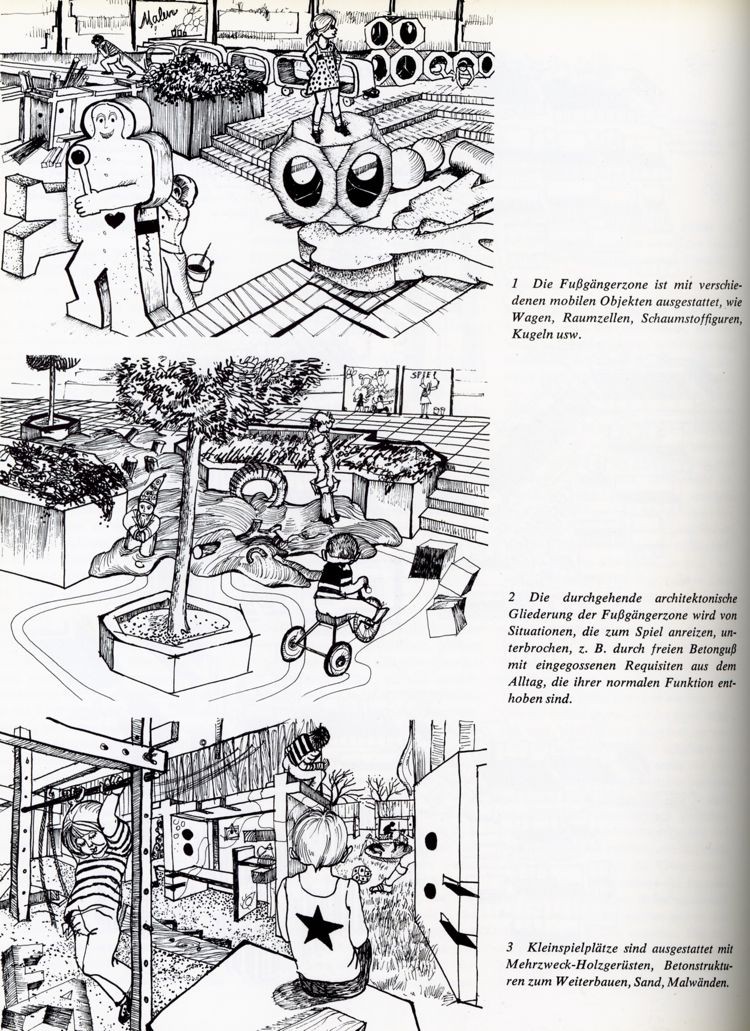
Spielkonzept Olympisches Dorf, Fussgängerzone, 1972
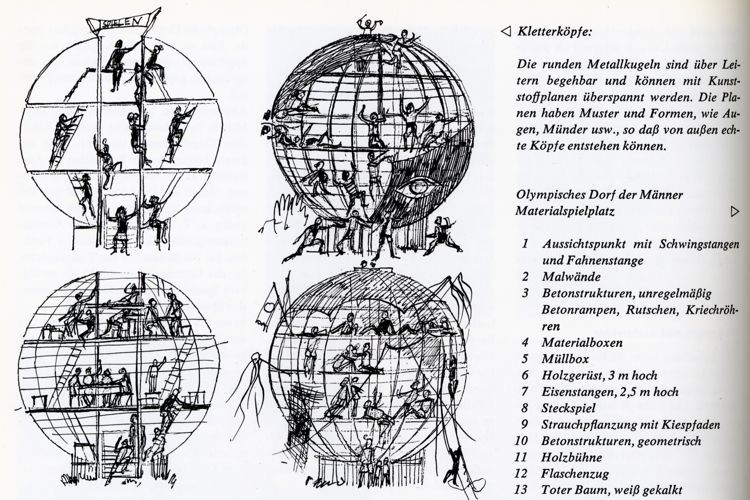
Spielsituationen „Kletterköpfe“